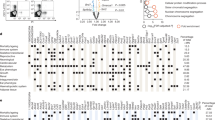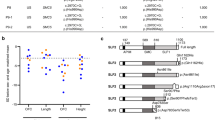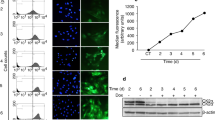Abstract
Functional impairment of DNA damage response pathways leads to increased genomic instability. Here we describe the centrosomal protein CEP152 as a new regulator of genomic integrity and cellular response to DNA damage. Using homozygosity mapping and exome sequencing, we identified CEP152 mutations in Seckel syndrome and showed that impaired CEP152 function leads to accumulation of genomic defects resulting from replicative stress through enhanced activation of ATM signaling and increased H2AX phosphorylation.
This is a preview of subscription content, access via your institution
Access options
Subscribe to this journal
Receive 12 print issues and online access
$209.00 per year
only $17.42 per issue
Buy this article
- Purchase on Springer Link
- Instant access to full article PDF
Prices may be subject to local taxes which are calculated during checkout


Similar content being viewed by others
Accession codes
References
Nyberg, K.A., Michelson, R.J., Putnam, C.W. & Weinert, T.A. Annu. Rev. Genet. 36, 617–656 (2002).
Cimprich, K.A. & Cortez, D. Nat. Rev. Mol. Cell Biol. 9, 616–627 (2008).
Bonner, W.M. et al. Nat. Rev. Cancer 8, 957–967 (2008).
O'Driscoll, M., Ruiz-Perez, V.L., Woods, C.G., Jeggo, P.A. & Goodship, J.A. Nat. Genet. 33, 497–501 (2003).
Murga, M. et al. Nat. Genet. 41, 891–898 (2009).
Majewski, F. & Goecke, T. Am. J. Med. Genet. 12, 7–21 (1982).
Rauch, A. et al. Science 319, 816–819 (2008).
Griffith, E. et al. Nat. Genet. 40, 232–236 (2008).
Guernsey, D.L. et al. Am. J. Hum. Genet. 87, 40–51 (2010).
Andersen, J.S. et al. Nature 426, 570–574 (2003).
Blachon, S. et al. Genetics 180, 2081–2094 (2008).
Doxsey, S.J., Stein, P., Evans, L., Calarco, P.D. & Kirschner, M. Cell 76, 639–650 (1994).
Lovejoy, C.A. et al. Proc. Natl. Acad. Sci. USA 106, 19304–19309 (2009).
Liu, Q. et al. Genes Dev. 70, 1448–1459 (2000).
Marti, T.M., Hefner, E., Feeney, L., Natale, V. & Cleaver, J.E. Proc. Natl. Acad. Sci. USA 103, 9891–9896 (2006).
Acknowledgements
We thank all family members who participated in this study, E. Milz, A. Alver and A. Coffey for excellent technical assistance, F. Kokocinski and A. Palotie for experimental design, and C. Kubisch, B. Wirth and K. Boss for critical reading the manuscript. The CINP antibody was a kind gift from D. Cortez (Nashville, Tennessee, USA). This work was supported by the German Federal Ministry of Education and Research (BMBF) by grant numbers 01GM0880 (SKELNET) and 01GM0801 (E-RARE network CRANIRARE) to B.W., the Karadeniz Technical University Research Fund by grant numbers 2008.114.001.02 and 2008.114.001.12 to E.K., the Medical Research Council and Lister Institute to A.P.J. and by the Wellcome Trust, grant 077014/Z/05/Z.
Author information
Authors and Affiliations
Contributions
The project was conceived and the experiments were planned by E.K. and B.W. We would like to note that Y.A. and K.E.B. had a comparable contribution to this study. The review of phenotypes and the sample collection were performed by B.W., E.K., Y.A., A.P.J., H.K., B. Tüysüz, W.K., B. Toraman., S. Kayipmaz, S. Kul, M.I., K.M., H.D., D.W., H.G.B. and A.R. Experiments were performed by E.K., G.Y., K.E.B., E.P., L.S.B., Y.L., M.K., I.B., K.B., D.J.T. and C.S. Data analysis was performed by B.W., E.K., G.N., P.N., A.K., J.A., M.S.T., M.H. and A.P.J. The manuscript was written by B.W., G.Y., E.K. and K.E.B. All aspects of the study were supervised by B.W.
Corresponding authors
Ethics declarations
Competing interests
The authors declare no competing financial interests.
Supplementary information
Supplementary Text and Figures
Supplementary Figures 1–8, Supplementary Tables 1–4 and Supplementary Methods (PDF 4081 kb)
Rights and permissions
About this article
Cite this article
Kalay, E., Yigit, G., Aslan, Y. et al. CEP152 is a genome maintenance protein disrupted in Seckel syndrome. Nat Genet 43, 23–26 (2011). https://doi.org/10.1038/ng.725
Received:
Accepted:
Published:
Issue Date:
DOI: https://doi.org/10.1038/ng.725
This article is cited by
-
Central nervous system vasculopathy and Seckel syndrome: case illustration and systematic review
Child's Nervous System (2021)
-
Thm2 interacts with paralog, Thm1, and sensitizes to Hedgehog signaling in postnatal skeletogenesis
Cellular and Molecular Life Sciences (2021)
-
Primary microcephaly with an unstable genome
Genome Instability & Disease (2020)
-
Alcohol metabolism contributes to brain histone acetylation
Nature (2019)
-
Verification and rectification of cell type-specific splicing of a Seckel syndrome-associated ATR mutation using iPS cell model
Journal of Human Genetics (2019)



